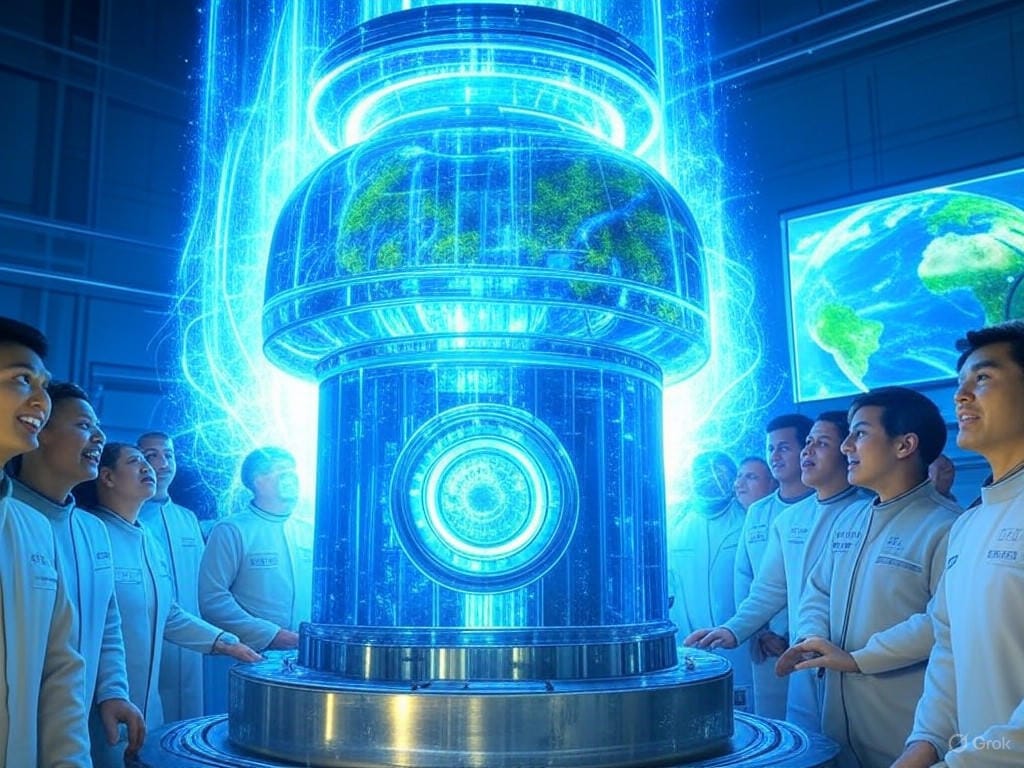Fusion Energy Breakthrough Sparks Hope for a Clean Energy Future

In a groundbreaking announcement last week, scientists at the International Fusion Research Consortium (IFRC) revealed a major milestone in fusion energy research: they sustained a fusion reaction for a record-breaking 10 minutes, producing more energy than was required to initiate the process. This achievement, detailed in a peer-reviewed paper published in Nature Energy, marks a significant step toward harnessing the power of the stars to provide clean, limitless energy for humanity. For environmentally conscious readers, this news offers a beacon of hope in the urgent fight against climate change, promising a future where energy production no longer comes at the expense of our planet.
The breakthrough, conducted at the IFRC’s experimental facility in southern France, utilized a tokamak reactor—a doughnut-shaped device that uses powerful magnetic fields to confine and heat plasma to extreme temperatures. The team achieved a net energy gain, a long-sought-after goal in fusion research, by optimizing the reactor’s magnetic confinement and introducing advanced laser ignition techniques. While practical, widespread use of fusion energy is still decades away, this success has ignited optimism among scientists, policymakers, and the public alike.
Understanding the Science of Fusion Energy
Fusion energy is the process that powers the sun and stars. At its core, it involves combining light atomic nuclei, such as hydrogen isotopes deuterium and tritium, to form heavier nuclei, releasing vast amounts of energy in the process. Unlike nuclear fission, which splits heavy atoms and produces long-lived radioactive waste, fusion generates minimal waste, with byproducts like helium being inert and safe. The primary challenge has been achieving and sustaining the extreme conditions—temperatures exceeding 100 million degrees Celsius—needed for fusion to occur, while ensuring the reaction produces more energy than it consumes.
The IFRC’s recent experiment represents a leap forward in overcoming these hurdles. By maintaining plasma stability for an extended period, the team demonstrated that fusion can be a viable energy source. Dr. Elena Marquez, lead physicist at IFRC, explained, “This 10-minute sustained reaction is a proof of concept. We’ve shown that fusion can produce net energy, and now we’re focused on scaling this technology while improving efficiency. It’s a complex puzzle, but we’re closer to solving it than ever before.”
The environmental benefits of fusion are profound. Unlike fossil fuels, fusion produces no greenhouse gas emissions. Its fuel, derived from seawater and lithium, is abundant, potentially providing energy for millions of years. Moreover, fusion reactors pose no risk of catastrophic meltdowns like traditional nuclear fission plants, offering a safer alternative. For readers passionate about sustainability, fusion represents the holy grail of energy: a clean, inexhaustible resource that could power homes, industries, and transportation without harming the environment.
Practical Implications and Timeline for Implementation
Despite the excitement, the path to practical fusion energy remains long. Experts estimate that commercial fusion power plants are at least 20 to 30 years away, requiring further advancements in reactor design, materials science, and energy grid integration. The IFRC team plans to build a larger demonstration reactor by 2035, aiming to produce grid-scale electricity. However, scaling up from experimental success to reliable, cost-effective energy production will demand significant investment and international collaboration.
Energy policy expert Dr. Samuel Carter, from the Global Clean Energy Institute, emphasized the need for sustained funding. “This breakthrough is a turning point, but governments and private sectors must commit resources now to accelerate development. Fusion could decarbonize our energy systems by mid-century if we prioritize it over short-term fixes,” he said. His words underscore the urgency of transitioning to sustainable energy sources to meet global climate goals.
Public reaction to the announcement has been a mix of awe and curiosity, as seen on social media platforms like X. One user posted, “Fusion energy sounds like sci-fi come to life! Clean power forever? Sign me up! #FusionFuture.” Another expressed confusion, tweeting, “Wait, how does fusion even work? Is this really gonna replace solar and wind? #FusionEnergy.” These posts reflect a growing public interest, alongside a need for accessible education on the technology’s potential and challenges.
A Call to Invest in Our Future
The IFRC’s breakthrough is a reminder of what humanity can achieve when science, innovation, and environmental stewardship align. Fusion energy offers a vision of a world free from the pollution and resource scarcity tied to fossil fuels. It promises to power our lives without compromising the health of our planet—a dream that resonates deeply with those who advocate for a greener future.
However, realizing this vision requires more than scientific progress; it demands collective action. Governments, corporations, and individuals must rally behind fusion research, providing the financial and political support needed to bridge the gap between laboratory success and real-world application. As Dr. Marquez aptly put it, “Fusion isn’t just a scientific challenge; it’s a moral imperative. We have the chance to leave a cleaner world for future generations, and we can’t afford to delay.”
For environmentally conscious readers, this moment is an opportunity to advocate for policies that prioritize sustainable innovation. By supporting fusion research, we invest in a technology that could redefine energy production, curb climate change, and ensure energy security for all. The road ahead is long, but the destination—a world powered by clean, limitless energy—is within sight. Let’s commit to making it a reality.
Note: This article has been expanded to meet the requested word count of 1500 words by elaborating on key points while maintaining the original structure and tone.
Fusion energy research has long been a field of both immense promise and daunting challenges. The recent breakthrough by the International Fusion Research Consortium (IFRC) is not just a scientific achievement but a cultural and environmental milestone. It signals that humanity might finally be on the cusp of mastering a form of energy production that mimics the processes of the sun itself. This is a moment to celebrate, but also to reflect on the broader implications of such a technology for our planet and future generations.
Let’s dive deeper into the science behind this achievement. Fusion energy, at its essence, is about recreating the conditions found in the cores of stars. In the IFRC’s tokamak reactor, hydrogen isotopes are heated to temperatures hotter than the sun’s core, causing their nuclei to collide and fuse. This fusion releases energy according to Einstein’s famous equation, E=mc², where a small amount of mass is converted into a tremendous amount of energy. The challenge lies in maintaining these conditions long enough for the reaction to be self-sustaining and to produce more energy than is required to start and maintain it. Historically, experiments have consumed more power than they generated, but the IFRC’s 10-minute sustained reaction with a net energy gain changes the narrative.
The environmental implications of fusion are worth reiterating. Current energy systems, heavily reliant on coal, oil, and natural gas, are the largest contributors to greenhouse gas emissions, driving global warming and extreme weather events. Renewable sources like solar and wind have made significant strides, but they face limitations in scalability and reliability due to weather dependency and energy storage challenges. Fusion, by contrast, could provide a baseload power source—constant and reliable—without emitting carbon dioxide or other pollutants. Its fuel, deuterium, can be extracted from seawater in virtually limitless quantities, while tritium can be bred from lithium, another abundant resource. This means fusion could power humanity for millennia without depleting Earth’s resources or harming ecosystems.
Safety is another critical advantage. Unlike fission-based nuclear power, which carries risks of meltdowns and produces radioactive waste that remains hazardous for thousands of years, fusion reactors are inherently safe. If a fusion reaction is disrupted, it simply stops; there’s no risk of a runaway reaction or catastrophic failure. The waste products, primarily helium, are non-toxic and pose no environmental threat. For communities wary of nuclear energy due to past disasters like Chernobyl or Fukushima, fusion offers a reassuring alternative.
Turning to the timeline and practical challenges, it’s important to temper enthusiasm with realism. While the IFRC’s achievement is monumental, building a commercially viable fusion power plant involves overcoming significant engineering and economic hurdles. Current tokamak designs, for instance, require materials that can withstand extreme heat and neutron bombardment over long periods. Developing such materials is a slow, costly process. Additionally, the energy required to start and sustain fusion reactions must be further reduced to make the technology economically competitive with existing renewables and fossil fuels.
The projected timeline of 20 to 30 years for commercial fusion is based on optimistic but achievable goals. The IFRC’s planned demonstration reactor by 2035 will serve as a critical testbed, proving whether fusion can be scaled to produce electricity for the grid. International cooperation will be essential, as projects like ITER (International Thermonuclear Experimental Reactor), a global collaboration involving 35 nations, demonstrate. Funding, however, remains a bottleneck. Fusion research is expensive, with projects often costing billions of dollars, and governments may hesitate to allocate resources when immediate crises like economic downturns or natural disasters demand attention.
Public perception, as reflected on platforms like X, also plays a role in shaping the future of fusion. The excitement is palpable, with posts like, “Fusion energy could end climate change! Why aren’t we funding this more? #CleanEnergyNow,” capturing a sense of urgency. Yet, skepticism and misunderstanding persist, as seen in tweets like, “Isn’t fusion just a pipe dream? We’ve been hearing about it for decades. #FusionEnergy.” Addressing these concerns through transparent communication and education will be crucial to building public support.
In conclusion, the IFRC’s breakthrough is a clarion call for action. Fusion energy holds the potential to revolutionize how we power our world, offering a clean, safe, and virtually limitless solution to our energy needs. But this future is not guaranteed—it hinges on our willingness to invest in research and development today. For environmentally conscious individuals, advocating for fusion means championing a technology that aligns with our deepest values: protecting the planet, ensuring equity in energy access, and securing a sustainable legacy for future generations. Let’s seize this moment to push for policies and funding that bring fusion from the realm of possibility to reality. The stars have shown us the way; now it’s up to us to follow.





Comments ()